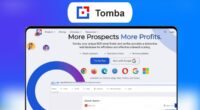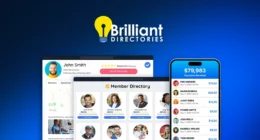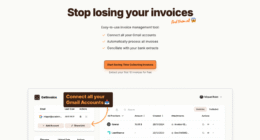Several leading marketing analytics platforms stand out in today’s market. Google Analytics offers robust tracking and seamless integration with other Google products, while HubSpot Marketing Hub combines CRM functionality with thorough analytics. Tableau excels in data visualization, and Adobe Analytics provides enterprise-level solutions with machine learning capabilities. For smaller businesses, alternatives like Mixpanel and Kissmetrics offer specialized features. The right choice depends on specific business needs, budget constraints, and desired analytical capabilities.
Quick Overview
- Google Analytics leads the industry with robust tracking capabilities, seamless Google product integration, and comprehensive website analytics features.
- HubSpot Marketing Hub combines CRM functionality with marketing analytics, making it ideal for businesses seeking an all-in-one solution.
- Tableau excels in data visualization, transforming complex marketing data into clear, actionable insights for better decision-making.
- Adobe Analytics offers enterprise-level solutions with advanced machine learning capabilities for predictive metrics and detailed audience analysis.
- Each platform should align with specific business needs, considering factors like budget, required features, and scalability potential.
Why Marketing Analytics Software Is Essential

Modern businesses need to cut through the noise of today’s crowded digital landscape, and marketing analytics software steps up as an indispensable tool for success. This powerful technology transforms raw data into actionable insights, enabling companies to make informed decisions rather than rely on guesswork.
Marketing analytics software empowers businesses to transform complex data into clear insights, replacing guesswork with strategic decision-making in today’s digital world.
Marketing analytics software proves essential by:
- Tracking campaign performance across multiple channels
- Measuring ROI and justifying marketing expenditures
- Understanding customer behavior and preferences
- Optimizing resource allocation in real-time
- Identifying market trends and competitive advantages
The software’s ability to provide data-driven insights helps businesses stay competitive while improving customer relationships. By analyzing key metrics and customer journey data, companies can create more targeted campaigns, reduce customer acquisition costs, and increase lifetime value. Advanced attribution models help marketers accurately distribute credit across different marketing programs for better campaign optimization. This systematic approach secures marketing efforts deliver measurable results and sustainable growth.
Top Contenders in the Analytics Platform Market
Competition in the marketing analytics landscape has created a diverse ecosystem of powerful platforms, each offering unique capabilities to help businesses harness their data. Industry leaders have emerged with specialized solutions that cater to different business needs and data complexity levels.
- Google Analytics remains the go-to choice for web analytics, offering robust tracking capabilities and seamless integration with other Google products. The platform’s event-based tracking provides deep insights into user behavior and interactions across multiple platforms.
- HubSpot Marketing Hub excels in combining CRM functionality with thorough marketing analytics, making it ideal for businesses seeking an all-in-one solution
- Tableau stands out for its superior data visualization tools, helping companies transform complex data into actionable insights
- Adobe Analytics leads in enterprise-level solutions, leveraging machine learning to deliver predictive metrics and detailed audience insights
These platforms represent the cutting edge of marketing analytics technology, each bringing distinct advantages to the table.
Key Features to Look for in Analytics Tools

Selecting the right marketing analytics tool requires a clear understanding of which features will best serve an organization’s specific needs. Modern analytics platforms should offer robust data integration capabilities to consolidate information from multiple channels while providing real-time insights. Tools that include targeted segmentation capabilities allow marketers to create more personalized and effective campaigns based on behavioral and demographic factors.
Essential features to prioritize include:
- Thorough data collection and integration across all marketing channels
- Interactive dashboards with customizable visualizations
- Detailed campaign tracking with KPI monitoring
- AI-powered predictive analytics for trend forecasting
- Automated reporting tools with export capabilities
The most effective platforms combine these capabilities with user-friendly interfaces and collaboration features. Special attention should be paid to visualization options, as they help transform complex data into actionable insights. Additionally, look for tools that offer scalability to handle growing datasets while maintaining performance and accuracy.
Real-World Applications and Success Stories
Companies across diverse industries have demonstrated the transformative power of marketing analytics through remarkable success stories. These real-world applications showcase how data-driven decisions lead to measurable business growth and enhanced customer engagement.
- Amazon revolutionized its marketing approach using conversion optimization analytics, resulting in a 25% sales increase within just three months. McDonald’s social media strategy leveraging real-time analytics delivered a 30% boost in customer engagement.
- Zara’s implementation of predictive analytics in inventory management led to a 20% cost reduction while boosting revenue by 5%.
- Glossier’s analytics-driven customer segmentation strategy achieved a 60% increase in retention rates and 20% growth in new customers.
- Nike’s real-time predictive analytics during campaign launches produced a 35% boost in conversion rates.
These success stories highlight how analytics tools can drive significant improvements across various business metrics and operational efficiency.
Choosing the Right Analytics Solution for Your Business

The decision to implement marketing analytics software represents a vital turning point for businesses seeking data-driven growth. Organizations must carefully evaluate several key factors to select the most suitable solution for their needs.
First, companies should assess their specific business objectives and internal capabilities, ensuring the chosen software aligns with their goals and team’s expertise.
Next, the evaluation process should focus on essential features like predictive analytics, data integration options, and customizable reporting capabilities. Security considerations are equally important, with emphasis on compliance with privacy regulations and robust data protection measures.
Budget constraints and potential ROI must be weighed carefully, including both immediate costs and long-term value.
Finally, user experience and vendor support play pivotal roles in successful implementation, making it essential to choose software that offers extensive training resources and reliable technical assistance.
Future Developments and Industry Trends
Innovation within marketing analytics continues to reshape how businesses understand and engage with their customers. The future of marketing analytics software is rapidly evolving, driven by technological advancements and changing consumer behaviors.
Key developments shaping the industry include:
- AI-powered predictive analytics tools that process vast amounts of data to forecast customer behavior and optimize marketing strategies
- Enhanced real-time analytics capabilities through edge computing, enabling instant decision-making and personalized customer experiences
- Democratized data access through self-service platforms, making complex analytics accessible to marketing teams without technical expertise
- Integration of advanced privacy features to comply with evolving regulations while maintaining effective data collection and analysis
These trends signal a shift toward more sophisticated, accessible, and privacy-conscious marketing analytics solutions that will define the next generation of business intelligence tools. Companies implementing ethical AI models are prioritizing trustworthy and accurate analytics results to maintain customer confidence and improve decision-making accuracy.
Frequently Asked Questions
How Long Does It Typically Take to Implement Marketing Analytics Software?
The implementation of marketing analytics software typically takes between 2 weeks to 6 months, depending on several key factors. Cloud-based solutions are faster, usually requiring 2-8 weeks, while on-premise systems take 3-6 months.
Implementation duration varies based on organizational size, data complexity, and system readiness. The process includes initial planning, data integration, user training, and testing phases.
Small businesses generally experience shorter implementation times than large enterprises.
Can Marketing Analytics Tools Integrate With Custom-Built or Legacy Systems?
Like pieces of a well-designed puzzle, marketing analytics tools can seamlessly integrate with both custom-built and legacy systems. Modern analytics platforms offer API-based connections and pre-built connectors that bridge the gap between different software environments.
Tools like HubSpot and Salesforce’s Pardot specifically support integration with older systems, while custom solutions can be developed for unique requirements. Data migration tools guarantee a smooth transfer and reformatting of information across platforms.
What Programming Skills Are Needed to Use Advanced Marketing Analytics Platforms?
Working with advanced marketing analytics platforms requires a diverse set of programming skills. Core requirements include Python for data manipulation and machine learning, SQL for database queries, and JavaScript for web analytics tracking. Data visualization skills using libraries like Matplotlib or ggplot2 are essential.
Additionally, professionals should understand API integration, cloud platforms like Snowflake, and automation tools. Knowledge of R programming is beneficial for statistical analysis and advanced modeling capabilities.
How Often Should Marketing Analytics Data Be Reviewed for Optimal Results?
Like a well-timed heartbeat, marketing analytics reviews should follow a consistent rhythm. The ideal review frequency varies by campaign type and business needs.
Daily monitoring works best for active campaigns needing quick adjustments, while weekly reviews suit content-heavy strategies. Monthly analysis provides balanced insights for overall performance, and quarterly deep-dives help with strategic planning.
For special events or launches, real-time monitoring becomes essential for immediate optimization.
Are There Industry-Specific Marketing Analytics Solutions for Niche Markets?
Yes, specialized marketing analytics solutions exist for various niche markets.
Healthcare organizations utilize HIPAA-compliant tools for patient engagement tracking, while e-commerce platforms focus on purchase behavior and cart abandonment analysis.
SaaS companies employ subscription-specific analytics for retention and churn prediction.
Retail businesses benefit from tools that combine in-store and online metrics.
These industry-specific solutions provide targeted insights that generic analytics platforms may miss.
Conclusion
Marketing analytics software has evolved from a “nice-to-have” into an indispensable business companion. While some organizations may experience temporary setbacks in implementation, the rewards of data-driven decision-making far outweigh initial hurdles. As the digital landscape continues its transformation, businesses that embrace these analytical tools position themselves to better understand their audience’s journey. The key lies not in choosing the perfect platform, but in selecting one that aligns with organizational goals and growth potential.








